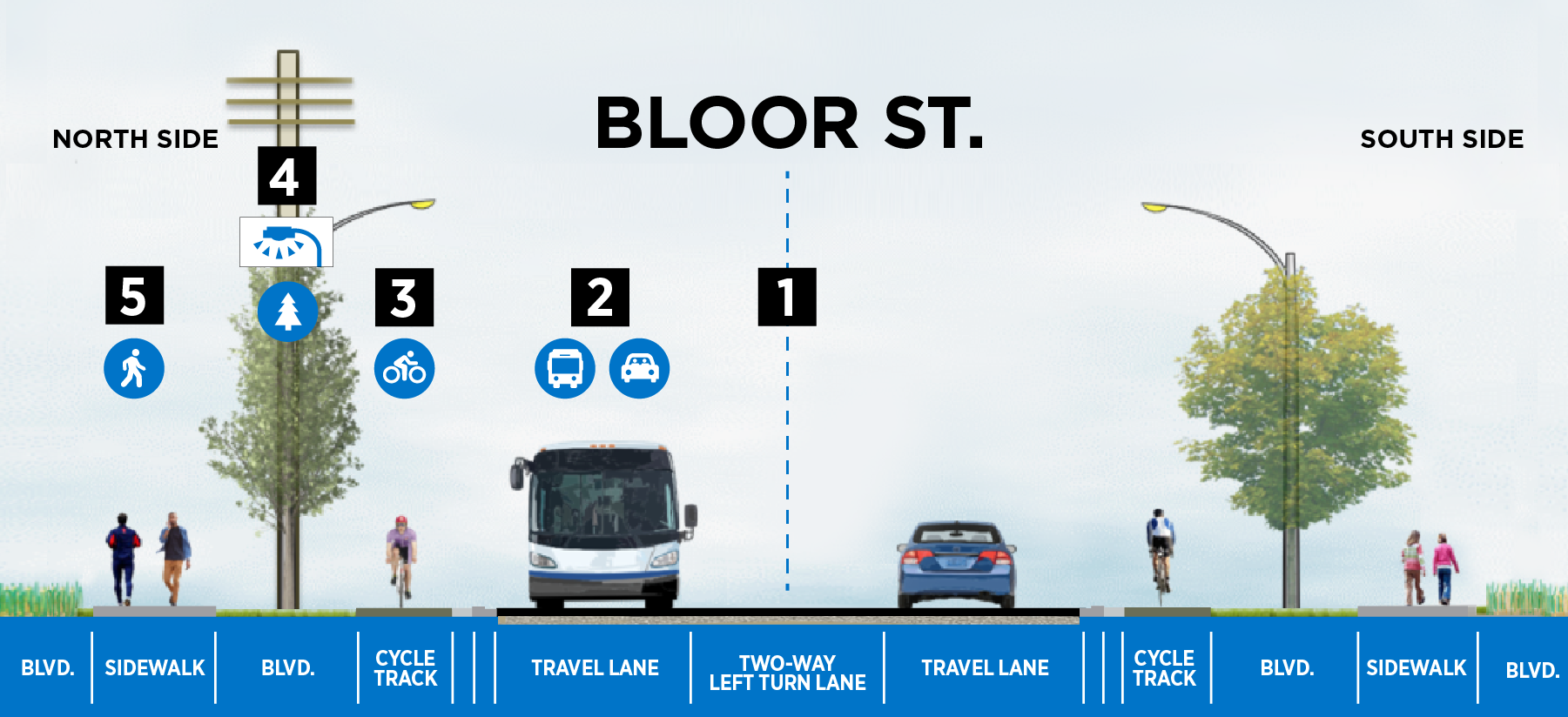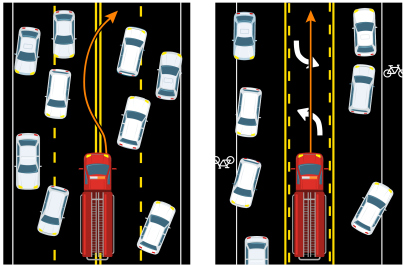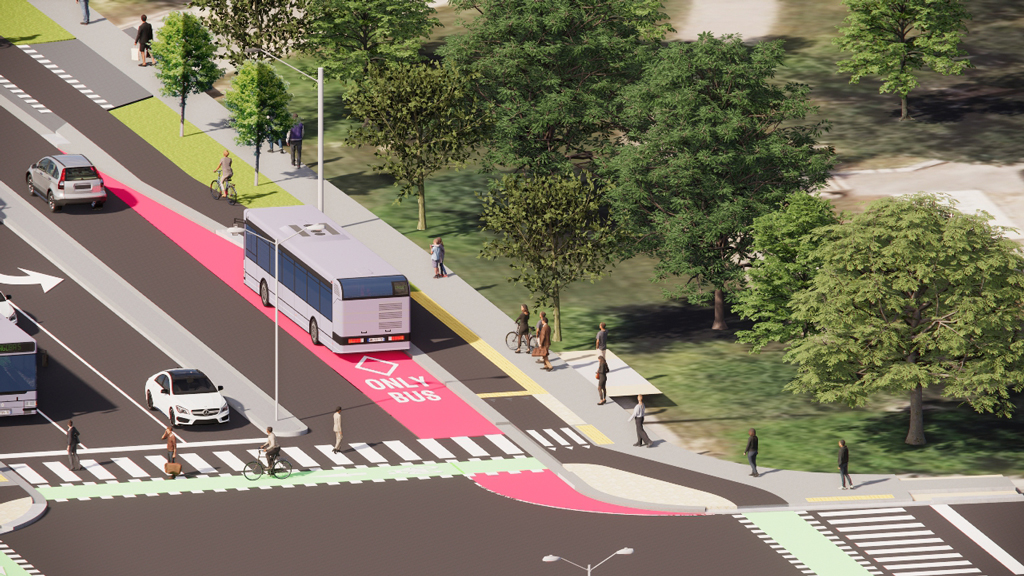Alternative 6, as approved by Council, offers the greatest number of road safety improvements than the other design alternatives considered in consultation with the public.
Staff reviewed the Applewood Heights Homeowners Residents Association (AHHRA) proposed “win-win-win” design which includes:
- Four travel lanes
- One-way cycle tracks immediately behind the curb and splash pad
- A narrow, vegetated boulevard
- Sidewalks
This proposal is the same as an earlier design alternative which was considered and screened out by the City’s study and consultations because:
- Four lanes provide fewer options for road safety improvements (the potential for rear-end and T-bone collisions as vehicles make left turns into driveways)
- Most of the boulevard would be hardscaped and most of the existing boulevard trees would be removed to accommodate the design (with limited soil ground for tree replacements)
- Four lanes continue to attract longer distance through-trips along the Bloor Street corridor and higher speeds during off-peak periods
- Most bus stops would need to be placed in lanes of traffic, with few options to install lay-bys
- Negative impacts to utilities, with costly and/or technically challenging relocations because of limited space.
The AHHRA’s proposed alternative also does not meet the City’s Vision Zero Action Plan and Complete Streets objectives and therefore couldn’t be supported by staff.
The design features of Alternative 6
We’re still working on detailed designs, but here’s what Bloor Street will look like when the project is complete:

- A centre left turn two-way lane to keep traffic flowing and make emergency vehicle access more predictable
- Two travel lanes (one in each direction) with lay-bys for transit buses at some intersections, so traffic is not blocked
- Bike lanes in the boulevard separated from the roadway on both sides (also known as cycle tracks)
- More trees where possible on both sides of the road in the boulevard to provide shade and a nice place to walk and improved lighting
- Widened sidewalks on both sides of the road to give people more space to move
The alternative 6 design will also include a new mid-block, signalized pedestrian crossing at Applewood Trail so people can cross the street safely.
The City’s commitment to Vision Zero aims to provide a safe and equitable transportation network that protects all road users, with specific emphasis on those most vulnerable such as pedestrians and cyclists.
The City’s Vision Zero Action Plan provides staff with actions to apply to the City’s road renewal and improvement projects.
The Vision Zero actions that supported the final design alternative and not the previous options include:
- Action 11: Narrower lane widths to improve speed compliance and reduce crossing distances
- Action 17: Protected and dedicated cycling infrastructure
- Action 18: Pedestrian Master Plan implementation: wider sidewalks
- Action 20: 2+1 Roadways: Transition 4-lane roads to 2+1 centre turn lane configuration
- Action 58: Mid-block protected crossings to improve access and pedestrian safety.
The goal of the Bloor Street Integrated Road Project was to identify road safety improvements that could be bundled and delivered along with the needed pavement rehabilitation and other infrastructure renewals.
Many studies reviewed the impact of changing four-lane roads to three lanes for emergency vehicles. These studies show that three-lane roads create easier and safer paths for emergency vehicles compared to four-lane configurations. In four lane traffic, emergency vehicles need two lanes of traffic merging out of their path. If drivers are not aware of the emergency vehicle or if there is no space for them to safely merge to the right, the emergency vehicle is delayed.
On roads with three lanes, there are fewer cars in the turning lanes which makes it easier and more predictable for those cars to pull out of that lane. Emergency vehicles can use the cleared centre two-way lane to travel to the emergency. Often, response times are improved with three lanes instead of four.

The image on the left shows a fire truck navigating the centre of a four-lane roadway and the resulting unpredictable movement of the cars moving off to the sides to clear a pathway.
The image on the right shows a predictable and safer pathway for a fire truck to move through the centre, two-way left-turn lane and cars moving off to the sides.
Bus routes 3, 8, 302, and 307 run along Bloor Street. Right now, most bus stops are at street corners. Some bus stops are in the middle of blocks and lack safe pedestrian crossings. As a part of the detailed design phase, we are reviewing adding more mid-block pedestrian crossings.
Initial designs include added bus bays (called lay-bys) which let buses pick-up and drop-off of passengers outside the travel lanes. We will confirm the exact number of lay-bys as a part of the detailed design phase.

As always, our goal remains to move people safely, efficiently and effectively along the corridor. You can find more about the traffic flow and studies we’ve done to support this goal.
Bloor Street was scheduled to be resurfaced, so there would be construction on the street regardless. As part of this project, we will be doing a full overhaul, so we don’t have to do it again in the future.
This saves time, taxpayer dollars, and reduces disruption for those who live and work along the corridor. We’re only doing this once.
The work includes:
- Asphalt road resurfacing
- Reconfiguring the travel lanes to one on either side, plus a centre left turn lane
- Widening the sidewalks on each side of the road
- Replace ageing curbs and realigning them
- Changing out catch basins and making repairs
- Repairing the drainage along the road to help divert water
- Replacing all the sod along the boulevards
- Adding more trees, where appropriate and possible, to create a thicker tree canopy, improve the micro-climate on the corridor, and give people shade.
The Bloor Street Integrated Road Project was chosen as part of the planned resurfacing of Bloor Street and the City’s goal of building complete streets everyone can use and feel safe. Many of the upcoming changes to the street are guided by the City’s Vision Zero Action Plan, and include new intersection controls, safer street lighting, active transportation like separated bike lanes and wider sidewalks, and transit infrastructure.
The projects listed above could all be separate projects, but they’ve been brought together into a single project to save time, money, and to reduce disruption to local residents.
The funding for Bloor Street incorporates the following infrastructure renewals and improvements, including but not limited to:
- Pavement rehabilitation
- Curb replacements and realignment
- Street light pole replacements and illumination improvements
- Additional boulevard trees where possible and appropriate to create more tree canopy and improve walking conditions
- Utility relocations (where required)
- Widened sidewalks
- New cycle tracks
- New signalized pedestrian crossing at Applewood Trail
- Crossrides (all signalized and unsignalized intersections)
- Protected intersections (to be confirmed during detailed design)
- Transit stop improvements, including bus lay-bys
Construction will begin in the Fall of 2024 and be complete by December 2025, with restoration work to be completed in 2026.
More details of the construction plan will be communicated to the community in advance including this website, social media, the Councillor’s website, and more.
Mississauga is not anti-car – in fact, far from it. We just believe everyone should have a chance to use our roadways and corridors. If you want to drive, nobody is stopping you. In fact, we have over 5600 lane kilometres of roads for car use.
We know cars are the preferred option for many people, but not all people. As the cost of owning a car goes up every year, many people are opting for bikes and e-bikes, e-scooters, transit, walking and other travel options. We need to make space for these people too.
We are working to build complete streets, where all forms of mobility are welcome and everyone is safe. We’re not forcing anyone to walk or ride their bike, but we are giving them the option to do so. With the price of gas, and well, everything going up, people need other options and not everyone has the ability to drive a car.
Beyond this, Mississauga is committed to tackling climate change head on. In fact, we have a Climate Change Action Plan that is working to lower emissions, by giving people options other than the car.
Finally, more and more people come to the GTA every year. We simply cannot build enough roads if everyone wants to drive. Corridors like Bloor Street that connect our city to our neighbours, provide a good opportunity to change how we design our streets to give more people, more options to move.
This is a common question we get asked a lot, and it’s a good one.
We are adding cycle tracks into the boulevard instead of bike lanes on the side of the road to improve safety.
For information, bike lanes are integrated with the roadway while cycle tracks are separated from the roadway. In this case, we have a chance to install cycle tracks, so we’re taking it.
If places where people ride their bikes aren’t protected and safe, most people won’t use them. Riding on the road beside cars, trucks and buses, without any protection, is not fun.
All around the world, when protected bike lanes are installed, more people ride in them. It doesn’t happen overnight, but over time, more people ride their bikes. We built roads to accommodate cars and we are doing the same with protected bike lanes.
We are confident that adding cycle tracks to the boulevard instead of bike lanes to the roadway will allow and encourage more people to get on their bikes and ride, instead of using the car. You can still drive, if you want, but you should have the option to ride your bike too.
This is a main corridor and a place where cyclists – both recreational and commuter – should be able to ride safely. Plus, there is a direct connection to the Applewood Trail, which will allow people to travel through our community on their bikes safely. Hundreds of people use this trail every day.
Bikes racks on Miway buses also help people commute more easily using transit and cycling trails.
Streets and roads should be safe for everyone who wants to use them, whether you drive, take transit, walk or even bike. The City’s Cycling Master Plan aims to make Mississauga a bike-friendly city and build 900 km of bike infrastructure in the next 25 years.
If you’ve ever ridden your bike in a live lane of traffic, or even in a painted bike lane, you know that it can be frightening. We’re working to change this in as many areas around the city where it makes sense to do so, including Bloor Street. We build protected spaces for bicycles so people feel safe to ride.
Yes, we are eliminating a lane on each side, but our studies show that this will not slow down traffic much at all. The centre left turn lane will allow people to access driveways, without blocking the traffic behind them.
But more than traffic flow, we are working to make our roads safer for everyone. As it is currently designed, speeds on Bloor Street are higher than the current speed limit of 50 km per hour because people feel comfortable driving fast.
Reducing a lane will slow speeds to the current speed limit and prevent serious injury for drivers, pedestrians and cyclists.
We’re glad you asked.
We will install a number of safety measures, including:
- Accessible transit stops
- Better ramping, tactile warning plates, improved signage and markings that meet the Accessibility for Ontarians with Disabilities Act requirements
- Dedicated space (called crossrides) for cyclists to ride through intersections safely without having to get off their bike
- Narrower travel lanes to make drivers pay attention more and slow down
- New street light poles to make walking and driving at night safer
- Reduced curb radiuses at all intersections which slows traffic and makes it easier for drivers to see pedestrians
A big part of this project is to make the road safer for everybody.
Mississauga is committed to Vision Zero, which is our pledge to have zero injuries or deaths on our roads. We do this by lowering speeds and by protecting everyone who uses our roadways.
We know many people drive, but not everyone does. For those who don’t, they should still be safe on our streets.

We are confident that the changes to Bloor Street will improve your experience if you live along the street. Here are some of the positive changes:
- Will provide a safer environment, including turning into and out of your driveway
- When entering your driveway, you will have your own left-turn lane
- Wider sidewalks will provide a more comfortable environment, and more trees will create more shade
- If you want to ride your bike, you will have your own safe space within the boulevard, including crossrides at all intersections
- Reduced traffic speed to the current speed limit of 50 km per hour will result in a safer street and decrease vehicle noise